
Worcestershire is a ceremonial county in the West Midlands of England. It is bordered by Shropshire, Staffordshire, and the West Midlands county to the north, Warwickshire to the east, Gloucestershire to the south, and Herefordshire to the west. The city of Worcester is the largest settlement and the county town.
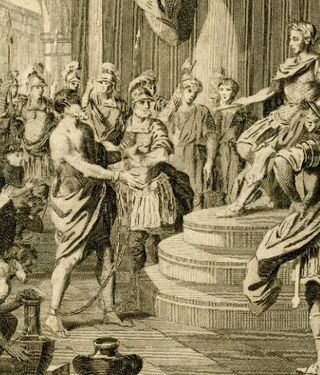
Caratacus was a 1st-century AD British chieftain of the Catuvellauni tribe, who resisted the Roman conquest of Britain.

The Malvern Hills are in the English counties of Worcestershire, Herefordshire and a small area of northern Gloucestershire, dominating the surrounding countryside and the towns and villages of the district of Malvern. The highest summit affords a panorama of the Severn Valley, the hills of Herefordshire and the Welsh mountains, parts of thirteen counties, the Bristol Channel, and the cathedrals of Worcester, Gloucester and Hereford.

Malvern is a spa town and civil parish in Worcestershire, England. It lies at the foot of the Malvern Hills, a designated Area of Outstanding Natural Beauty. The centre of Malvern, Great Malvern, is a historic conservation area, which grew dramatically in Victorian times due to the natural mineral water springs in the vicinity, including Malvern Water.

Herefordshire is a ceremonial county in the West Midlands region of England. It is bordered by Shropshire to the north, Worcestershire to the east, Gloucestershire to the south-east, and the Welsh counties of Monmouthshire and Powys to the west. The city of Hereford is the largest settlement and the county town.
The final battle in Caratacus' resistance to Roman rule was fought in 50 AD. The Romans under Publius Ostorius Scapula defeated the Britons and in the aftermath captured Caratacus himself, since 43 the leader of armed opposition to the Roman conquest of Britain. He was paraded through Rome and given the opportunity to make a speech before the emperor Claudius, who spared his life and those of his family and retainers.

Worcestershire Beacon, also popularly known as Worcester Beacon, or locally simply as The Beacon, is a hill whose summit at 425 metres (1,394 ft) is the highest point in Worcestershire. It is part of the Malvern Hills which run about 13 kilometres (8.1 mi) north-south along the Herefordshire-Worcestershire border.

Leintwardine is a small to mid-size village and civil parish in north Herefordshire, England, close to the border with Shropshire.
Roger de Breteuil, 2nd Earl of Hereford, succeeded in 1071 to the earldom of Hereford and the English estate of his father, William Fitz-Osbern. He is known to history for his role in the Revolt of the Earls.
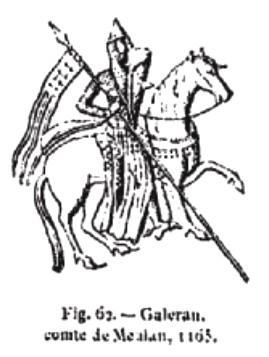
Waleran de Beaumont (1104–1166) was an Anglo-Norman nobleman. In his early adulthood, he was a member of the conspiracy of Amaury III of Montfort; later in his career, he participated in the Anarchy and the Second Crusade. During the reign of Henry II of England, Waleran's close ties to Louis VII of France caused him to fall out of grace.
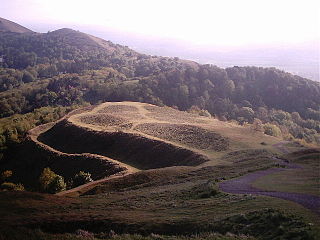
The Herefordshire Beacon is one of the highest peaks of the Malvern Hills. It is surrounded by a British Iron Age hill fort earthwork known as British Camp. The fort subsequently had a ringwork and bailey castle built inside its boundary and there is evidence of 120 huts in the area. British Camp has been a scheduled monument since 1923.
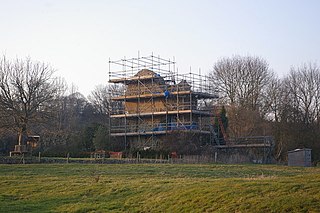
Wigmore Abbey was an abbey of Canons Regular with a grange, from 1179 to 1530, situated about a mile (2 km) north of the village of Wigmore, Herefordshire, England: grid reference SO 410713. Only ruins of the abbey now remain and on Historic England's Heritage at Risk Register their condition is listed as 'very bad'.

Clifford Castle is a ruined castle in the village of Clifford which lies 2.5 miles to the north-east of Hay-on-Wye in the Wye Valley in Herefordshire, England. It was the caput of the feudal barony of Clifford, a Marcher Lordship. The castle stands in the grounds of a private house and is only open to the public on certain days of the year.

Huntington Castle was situated in the village of Huntington in Herefordshire, England, 2+1⁄2 miles south-west of Kington.
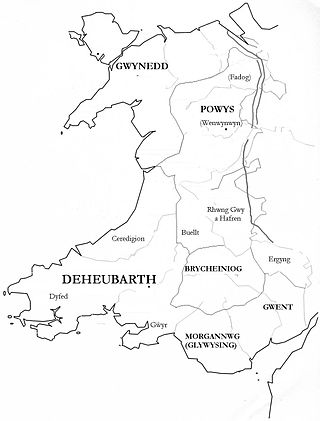
Bernard de Neufmarché, also Bernard of Newmarket or Bernard of Newmarch was the first of the Norman conquerors of Wales. He was a minor Norman lord who rose to power in the Welsh Marches before successfully undertaking the invasion and conquest of the Kingdom of Brycheiniog between 1088 and 1095. Out of the ruins of the Welsh kingdom he created the Anglo-Norman lordship of Brecon.
Stapleton is a small village and civil parish in Herefordshire near the border town of Presteigne in Wales. The parish borders on Willey, Kinsham and Presteigne. Stapleton is surrounded by farmland. Bryan's Ground gardens are open to the public.
Ewyas was a possible early Welsh kingdom which may have been formed around the time of the Roman withdrawal from Britain in the 5th century. The name was later used for a much smaller commote or administrative sub-division, which covered the area of the modern Vale of Ewyas and a larger area to the east including the villages of Ewyas Harold and Ewyas Lacy.

The Malvern Museum in Great Malvern, the town centre of Malvern, Worcestershire, England, is located in the Priory Gatehouse, the former gateway to the Great Malvern Priory. The museum was established in 1979 and is owned and managed by the Malvern Museum Society Ltd, a registered charity. The Priory Gatehouse was a gift to the museum in 1980 from the de Vere Group, the owners of the neighbouring Abbey Hotel, and is staffed by volunteers. As such, the building itself is the museum's major exhibit.

Midsummer Hill is situated in the range of Malvern Hills that runs approximately 13 kilometres (8 mi) north-south along the Herefordshire-Worcestershire border. It lies to the south of Herefordshire Beacon with views to Eastnor Castle. It has an elevation of 284 metres (932 ft). To the north is Swinyard Hill. It is the site of an Iron Age hill fort which spans Midsummer Hill and Hollybush Hill. The hillfort is protected as a Scheduled Ancient Monument and is owned by Natural England. It can be accessed via a footpath which leads south from the car park at British Camp on the A449 or a footpath which heads north from the car park in Hollybush on the A438.
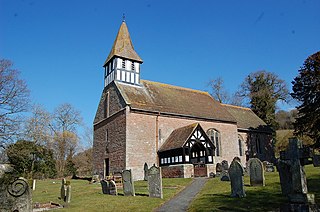
Castle Frome is a village and civil parish in the county of Herefordshire, England, and is 10 miles (16 km) north-east from the city and county town of Hereford. The closest large town is the market town of Bromyard, 5 miles (8 km) to the north. The Norman font in Castle Frome church is "one of the outstanding works of the Herefordshire school".



















